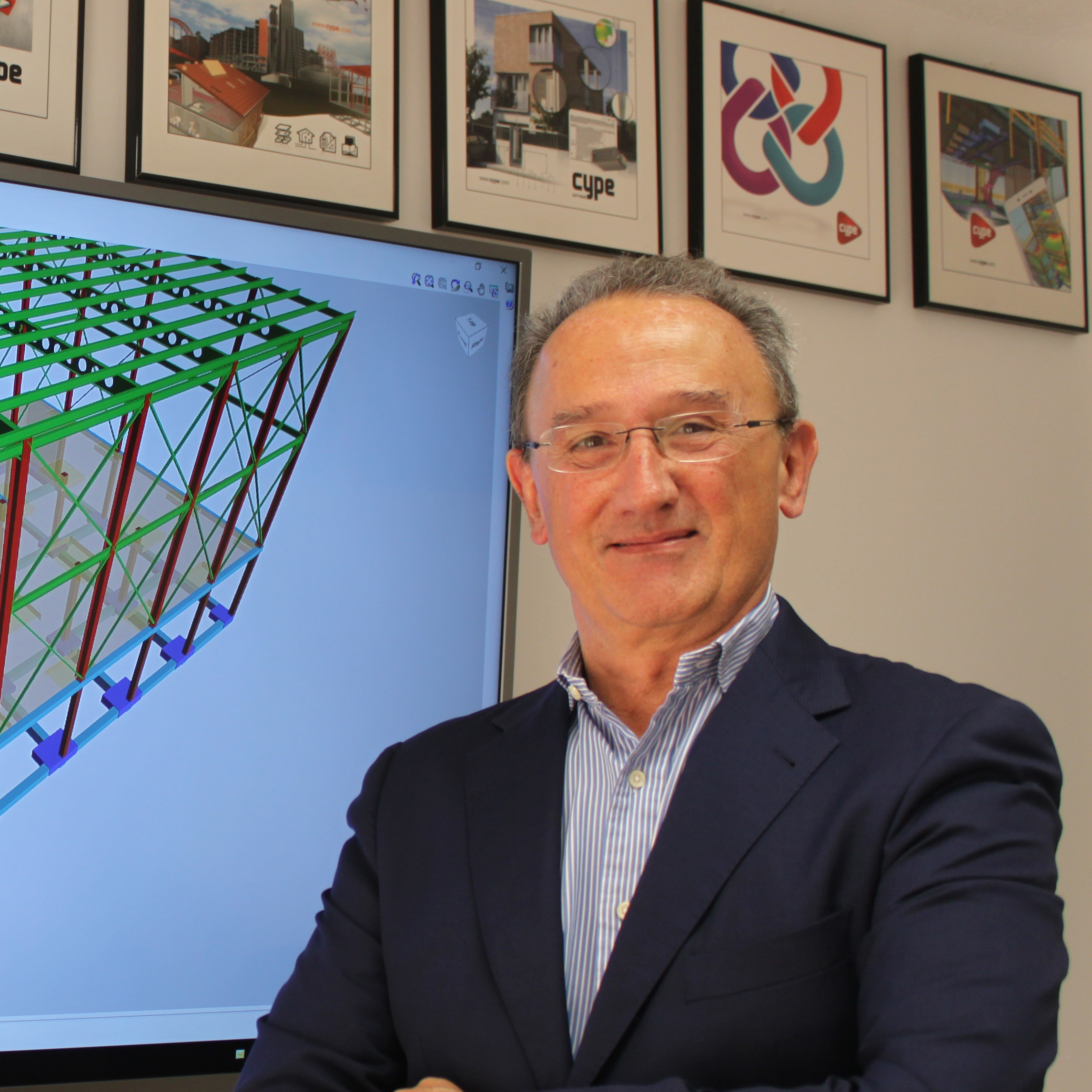CYPE has expanded its range of services for companies with the creation of Open BIM Systems, a new area aimed at companies and manufacturers in the architecture, engineering and construction industry that are interested in integrating their products into BIM projects and improving their assignment among professionals in the industry. We speak with Miguel Socorro, head of Open BIM integration at CYPE:
What are the reasons that have led CYPE to develop this new area aimed at companies and manufacturers in the construction industry?
The major breakthrough in the technological industry in recent years has resulted in a radical change in the way most professional activities work. The construction industry and project development have not been left behind in this respect, with the BIM methodology being responsible for offering digital solutions that allow designers to shorten times and optimise results.
The main reason for CYPE to develop this service is to provide a solution to a long-standing problem among software developers: open compatibility between 3D modelling tools and specialised analysis applications.
Up until now, an ordinary designer has had to go through one of the large 3D modelling platforms, which have a high annual maintenance cost and simply provide a spatial layout of the elements used based on the designer's criteria.
In order to be able to choose these elements with a certain level of judgement, designers were obliged, firstly, to be aware of the codes and, secondly, to use manual analyses, spreadsheets or, in ideal cases, some kind of analysis application to help them in this area.
What CYPE aims to do with Open BIM Systems is to offer any user the possibility of designing their installation using real products and their features free of charge, to have criteria based on analyses and code justifications and to visualise the real 3D representation of each element in their project.
What it offers manufacturers is a showcase that everyone can browse through to use their products free of charge, and which improves the assigning of their products.
"Designers working in BIM have the ability to design using real products with their features free of charge, to have criteria based on analyses and code justifications, and to visualise the real 3D representation of each element in their project”
Nowadays, the use of BIM technology is slowly spreading among designers and software developers, but are building material manufacturers also making a commitment to adapt their products to this technology or are they lagging behind?
More and more designers are asking manufacturers to offer their products in a digital format. The fact is that most manufacturers are trying to anticipate the needs of their customers and have been interested in BIM technology for some time now.
Of course, there are many companies that, for different reasons, have not yet undertaken this transition from their paper and PDF catalogue to a digital content format, but that is where Open BIM Systems comes in. Ultimately, however, our intention is to reach them all in one way or another, as those who have invested a certain amount of money in the digitisation of their elements usually end up realising that they still need to take a step further to make that investment functional by giving it the extra that our analysis applications provide.
When integrating products from companies and manufacturers into BIM projects, what format do you work in at CYPE, and why? What are the advantages offered by this type of file?
To ensure a fully open and compatible system between BIM tools, the only possible format for exchanging information is the IFC file format. This choice is self-evident.
At CYPE you are already carrying out several integration projects of manufacturers' products to BIM technology. First of all, you carry out a BIM assessment with the client in order to identify their needs and objectives. In the assessments you have carried out, what are the most common shortcomings you have found? When it comes to the advice you provide, what attracts your clients the most?
In order to be able to offer a service that meets the needs of each manufacturer, a specific analysis of each product's features is essential. This way, the applications that we offer to each company provide their customers with real solutions for executing each project.
The main problem that companies normally encounter is applying their own analysis criteria to the installed systems. Each product is different and in order to perfectly define an element, it is impossible to establish a generic definition of features, analysis parameters or selection procedures. Custom programming has to be carried out for each product, which is what we do, and is what our clients value the most.
Open BIM Systems develops exclusive software for each company's products. What added features and benefits does this tool offer manufacturers compared to other applications on the market?
The main advantage of the system we offer is precisely that: a system. Instead of defining a library consisting of individual elements with no connection between them, what we have developed is an application that allows us to enter a system of interconnected elements, with mutual influence and, sometimes, incompatibility with other elements from other brands... What doesn't make sense, for example, is defining an air-conditioning unit with an outdoor unit from one brand and an indoor unit from a different one... Or running water through a pipe with one diameter and, at a certain point, changing the diameter without a transition element... These kinds of things cannot be executed and, for this reason, we help users to avoid making design errors.
On top of that, we evaluate their influence with other disciplines and reduce parameter entry times by reusing information that is already available in the project. These are all advantages!
In terms of the product information you describe in detail, what sections or areas are included in Open BIM Systems? Technical, commercial and reference information, material composition, contact details...
The information included in an Open BIM System is no more and no less than what is needed for the equipment to be correctly defined. Both the data input and the output of results can include technical data sheets, prices, justification reports... any document or specification provided by the manufacturer has a place in this type of application.
The generation of a three-dimensional model for each element and its digitised view are two of the features of the work carried out by CYPE. What benefits do they provide to both the manufacturer and the designer?
For manufacturers, it is clear that placing their elements in three-dimensional models of buildings is a plus in terms of brand visualisation. Moreover, the most important thing is that it has become an essential requirement for executing BIM projects, so the value it provides is essential to ensure that they are not left out of the market's needs.
For designers, viewing a 3D element in the building as a whole solves many geometrical problems that appear unexpectedly when executing an installation, and that can be solved beforehand in the design phase.
“Connecting the applications to BIMserver.center provides the manufacturer with a virtual showcase with which they can reach thousands of professional users and their projects”
In terms of the profile of companies or manufacturers that want to create a BIM catalogue for their products, is there any limitation in terms of their field of specialisation?
The system is designed so that any company in the industry can have an Open BIM System for their products. It is not restricted to any particular field of specialisation - quite the opposite! In fact, our aim is to include companies from all disciplines.
This means that even an awning manufacturer could be interested in adapting their catalogue to this technology...
Of course. It may seem like a forced example, but it certainly isn't... An awning manufacturer would have a program capable of displaying the retraction mechanism, the fabric's appearance, the shadows cast depending on the date and time... But, as I say, it's just an example. The same applies to manufacturers that produce flooring, kitchen furniture, sanitary equipment, pipes and ducts... We could spend a whole day listing elements because, in the end, they are all elements.
As a result, this integration provides a powerful sales and marketing channel for manufacturers...
Ultimately, manufacturers want their products to be the ones chosen to be installed in projects... If we give designers a series of tools that allow them to select elements and place them in the project space, what we guarantee is that the quality chosen at the office is executed on site... We try to tackle the specification problem right from the moment of design. And also that this design is carried out following criteria. We give manufacturers what they want, which is to sell more, and we offer designers productivity solutions with real elements. Everybody wins.
CYPE also connects the software developed for manufacturers with their products in IFC format to the BIMserver.center platform, which has more than 120,000 users and almost 400,000 active projects. What advantages does it offer them as manufacturers to have their products visible on the platform?
BIMserver.center is a platform that manages and supports the entire system of Open BIM interactions. Its aim is to establish connections between all the agents involved in a construction project. It therefore offers a series of services such as placing programs in the Store, providing access to these programs for the educational community, monitoring the use of each application and each product... It is a virtual showcase for reaching thousands of professional users and their projects.
We manage the connection between developer and designer, between designer and manufacturer, we offer a service where a specialist in a certain discipline can have access to projects in which they can take part in order to address their area, and we offer manufacturers the access to execution projects for which they can send cost estimates...
What we are doing is offering a complete solution for all levels of project development, and in this respect, manufacturers play a key role for us.





